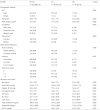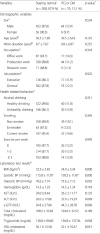1. Zimmet P. Globalization, coca-colonization and the chronic disease epidemic: can the Doomsday scenario be averted? J Intern Med. 2000; 247:301–10. DOI:
10.1046/j.1365-2796.2000.00625.x. PMID:
10762445.
2. Wild S, Roglic G, Green A, Sicree R, King H. Global prevalence of diabetes: estimates for the year 2000 and projections for 2030. Diabetes Care. 2004; 27:1047–53. DOI:
10.2337/diacare.27.5.1047. PMID:
15111519.
3. Park SW, Kim DJ, Min KW, Baik SH, Choi KM, Park IB, et al. Current status of diabetes management in Korea using National Health Insurance Database. J Korean Diabetes Assoc. 2007; 31:362–7. DOI:
10.4093/jkda.2007.31.4.362.
4. Wannamethee G, Ebrahim S, Shaper AG. Gamma-glutamyltransferase: determinants and association with mortality from ischemic heart disease and all causes. Am J Epidemiol. 1995; 142:699–708. PMID:
7572939.
5. Marchesini G, Brizi M, Bianchi G, Tomassetti S, Bugianesi E, Lenzi M. Nonalcoholic fatty liver disease: a feature of the metabolic syndrome. Diabetes. 2001; 50:1844–50. DOI:
10.2337/diabetes.50.8.1844. PMID:
11473047.
6. Karp DR, Shimooku K, Lipsky PE. Expression of gamma-glutamyl transpeptidase protects ramos B cells from oxidationinduced cell death. J Biol Chem. 2001; 276:3798–804. DOI:
10.1074/jbc.M008484200. PMID:
11080500.
7. Carlisle ML, King MR, Karp DR. Gamma-glutamyltranspeptidase activity alters the T cell response to oxidative stress and Fas-induced apoptosis. Int Immunol. 2003; 15:17–27. DOI:
10.1093/intimm/dxg010. PMID:
12502722.
8. Takahashi Y, Oakes SM, Williams MC, Takahashi S, Miura T, Joyce-Brady M. Nitrogen dioxide exposure activates gamma-glutamyltransferase gene expression in rat lung. Toxicol Appl Pharmacol. 1997; 143:388–96. DOI:
10.1006/taap.1996.8087. PMID:
9144455.
9. Perry IJ, Wannamethee SG, Shaper AG. Prospective study of serum gamma-glutamyl transferase and risk of NIDDM. Diabetes Care. 1998; 21:732–7. DOI:
10.2337/diacare.21.5.732. PMID:
9589232.
10. Lee DH, Jacobs DR Jr, Gross M, Kiefe CI, Roseman J, Lewis CE, et al. Gamma-glutamyl transferase is a predictor of incident diabetes and hypertension: the Coronary Artery Risk Development in Young Adults (CARDIA) Study. Clin Chem. 2003; 49:1358–66. DOI:
10.1373/49.8.1358. PMID:
12881453.
11. Lee DH, Ha MH, Kim JH, Christiani DC, Gross MD, Steffes M. Gamma-glutamyl transferase and diabetes - a 4 year follow-up study. Diabetologia. 2003; 46:359–64. DOI:
10.1007/s00125-003-1226-1. PMID:
12687334.
12. Lee DH, Silventoinen K, Jacobs DR Jr, Jousilahti P, Tuomileto J. Gamma-Glutamyl transferase, obesity, and the risk of type 2 diabetes: observational cohort study among 20,158 middle-aged men and women. J Clin Endocrinol Metab. 2004; 89:5410–4. DOI:
10.1210/jc.2004-0505. PMID:
15531490.
13. Nakanishi N, Suzuki K, Tatara K. Serum gamma-glutamyltransferase and risk of metabolic syndrome and type 2 diabetes in middle-aged Japanese men. Diabetes Care. 2004; 27:1427–32. DOI:
10.2337/diacare.27.6.1427. PMID:
15161799.
14. Rantala AO, Lilja M, Kauma H, Savolainen MJ, Reunanen A, Kesaniemi YA. Gamma-glutamyltranspeptidase and the metabolic syndrome. J Intern Med. 2000; 248:230–8. DOI:
10.1046/j.1365-2796.2000.00723.x. PMID:
10971790.
15. Hanley AJ, Williams K, Festa A, Wagenknecht LE, D’Agostino RB Jr, Kempf J, et al. Elevations in markers of liver injury and risk of type 2 diabetes: the insulin resistance atherosclerosis study. Diabetes. 2004; 53:2623–32. DOI:
10.2337/diabetes.53.10.2623. PMID:
15448093.
16. Sattar N, Scherbakova O, Ford I, O’Reilly DS, Stanley A, Forrest E, et al. Elevated alanine aminotransferase predicts new-onset type 2 diabetes independently of classical risk factors, metabolic syndrome, and C-reactive protein in the west of Scotland coronary prevention study. Diabetes. 2004; 53:2855–60. DOI:
10.2337/diabetes.53.11.2855. PMID:
15504965.
17. Cho NH, Lee HK, Jang HC, Chan JCN, Choi SH, Lim S, Kim HR. Abnormal liver function test predicts type 2 diabetes: a community-based prospective study. Diabetes Care. 2007; 30:2566–8. DOI:
10.2337/dc07-0106. PMID:
17626893.
18. Vozarova B, Stefan N, Lindsay RS, Saremi A, Pratley RE, Bogardus C, et al. High alanine aminotransferase is associated with decreased hepatic insulin sensitivity and predicts the development of type 2 diabetes. Diabetes. 2002; 51:1889–95. DOI:
10.2337/diabetes.51.6.1889. PMID:
12031978.
19. Kwon JH, An YS, Kang YH, Son SM, Kim IJ, Kim YK. Alanine aminotransferase as a predictor of metabolic syndrome in Koreans. J Korean Endocr Soc. 2008; 23:404–12. DOI:
10.3803/jkes.2008.23.6.404.
20. Kim CG, Kim JS, Jung JG, Kim SS, Yoon SJ, Suh HS. Reliability and validity of alcohol use disorder identification test-Korean revised version for screening at-risk drinking and alcohol use disorders. Korean J Fam Med. 2014; 35:2–10. DOI:
10.4082/kjfm.2014.35.1.2. PMID:
24501664.
21. American Diabetes Association. Standards of medical care in diabetes-2014. Diabetes Care. 2014; 37(Suppl 1):S14–80. DOI:
10.2337/dc14-S014. PMID:
24357209.
23. Nakanishi N, Nishina K, Li W, Sato M, Suzuki K, Tatara K. Serum gamma-glutamyltransferase and development of impaired fasting glucose or type 2 diabetes in middle-aged Japanese men. J Intern Med. 2003; 254:287–95. DOI:
10.1046/j.1365-2796.2003.01198.x. PMID:
12930239.
24. Ohlson LO, Larsson B, Bjorntorp P, Eriksson H, Svardsudd K, Welin L, Tibblin G, Wilhelmsen L. Risk factors for type 2 (non-insulin-dependent) diabetes mellitus. Thirteen and one-half years of follow-up of the participants in a study of Swedish men born in 1913. Diabetologia. 1988; 31:798–805. DOI:
10.1007/BF00277480. PMID:
3234634.
25. Finelli C, Tarantino G. What is the role of adiponectin in obesity related non-alcoholic fatty liver disease? World J Gastroenterol. 2013; 19:802–12. DOI:
10.3748/wjg.v19.i6.802. PMID:
23430039.
26. Tarantino G, Capone D. Inhibition of the mTOR pathway: A possible protective role in coronary artery disease. Ann Med. 2013; 45:348–56. DOI:
10.3109/07853890.2013.770333. PMID:
23668688.
27. Finelli C, Tarantino G. What about non-alcoholic fatty liver disease as a new criterion to define metabolic syndrome? World J Gastroenterol. 2013; 19:3375–84. DOI:
10.3748/wjg.v19.i6.802. PMID:
23801829.
28. Caputi A, Tarantino G. JNKs, insulin resistance and inflammation: A possible link between NAFLD and coronary artery disease. World J Gastroenterol. 2011; 17:3785–94. DOI:
10.3748/wjg.v17.i33.3785. PMID:
21987620.
29. Nannipieri M, Gonzales C, Baldi S, Posadas R, Williams K, Haffner SM, et al. Liver enzymes, the metabolic syndrome, and incident diabetes: the Mexico City diabetes study. Diabetes Care. 2005; 28:1757–62. DOI:
10.2337/diacare.28.7.1757. PMID:
15983331.
30. Andre P, Balkau B, Born C, Charles MA, Eschwege E. Three-year increase of gamma-glutamyltransferase level and development of type 2 diabetes in middle-aged men and women: the D.E.S.I.R. cohort. Diabetologia. 2006; 49:2599–603. DOI:
10.1007/s00125-006-0418-x. PMID:
16969645.
31. Lee DH, Blomhoff R, Jacobs DR Jr. Is serum gamma-glutamyltransferase a marker of oxidative stress? Free Radic Res. 2004; 38(6):535–9. DOI:
10.1080/10715760410001694026. PMID:
15346644.
32. Yokoyama H, Hirose H, Moriya S, Saito I. Significant correlation between insulin resistance and serum gamma-glutamyltranspeptidase (gamma-GTP) activity in non-drinkers. Alcohol Clin Exp Res. 2002; 26:91S–94S. PMID:
12198383.
33. Ortega E, Koska J, Salbe AD, Tataranni PA, Bunt JC. Serum gamma-glutamyl transpeptidase is a determinant of insulin resistance independently of adiposity in Pima Indian children. J Clin Endocrinol Metab. 2006; 91:1419–22. DOI:
10.1210/jc.2005-1783. PMID:
16434459.
34. Pradhan AD, Manson JE, Rifai N, Buring JE, Ridker PM. C-reactive protein, interleukin 6, and risk of developing type 2 diabetes mellitus. JAMA. 2001; 286:327–34. DOI:
10.1001/jama.286.3.327. PMID:
11466099.
35. Freeman DJ, Norrie J, Caslake MJ, Gaw A, Ford I, Lowe GD, et al. C-reactive protein is an independent predictor of risk for the development of diabetes in the West of Scotland Coronary Prevention Study. Diabetes. 2002; 51:1596–600. DOI:
10.2337/diabetes.51.5.1596. PMID:
11978661.
36. Campos SP, Baumann H. Insulin is a prominent modulator of the cytokine-stimulated expression of acute-phase plasma protein genes. Mol Cell Biol. 1992; 12:1789–97. DOI:
10.1128/MCB.12.4.1789. PMID:
1372389.
37. Ceriello A, Motz E. Is oxidative stress the pathogenic mechanism underlying insulin resistance, diabetes, and cardiovascular disease? The common soil hypothesis revisited. Arterioscler Thromb Vasc Biol. 2004; 24:816–23. DOI:
10.1161/01.ATV.0000122852.22604.78. PMID:
14976002.
38. Lee MY, Weon CS, Ko CH, Lee BJ, Lee Y, Kim MJ, et al. Relations between serum gamma-glutamyltransferase and prevalence of diabetes mellitus. Korean J Med. 2004; 67:498–505.
39. Kim DJ, Noh JH, Cho NH, Lee BW, Choi YH, Jung JH, et al. Serum gamma-glutamyltransferase within its normal concentration range is related to the presence of diabetes and cardiovascular risk factors. Diabet Med. 2005; 22(9):1134–40. DOI:
10.1111/j.1464-5491.2005.01581.x. PMID:
16108838.
41. Wei M, Gaskill SP, Haffner SM, Stern MP. Waist circumference as the best predictor of noninsulin dependent diabetes mellitus (NIDDM) compared to body mass index, waist/hip ratio and other anthropometric measurements in Mexican Americans - a 7-year prospective study. Obes Res. 1997; 5:16–23. DOI:
10.1002/j.1550-8528.1997.tb00278.x. PMID:
9061711.
42. Stevens J, Couper D, Pankow J, Folsom AR, Duncan BB, Nieto FJ, et al. Sensitivity and specificity of anthropometrics for the prediction of diabetes in a biracial cohort. Obes Res. 2001; 9:696–705. DOI:
10.1038/oby.2001.94. PMID:
11707536.







